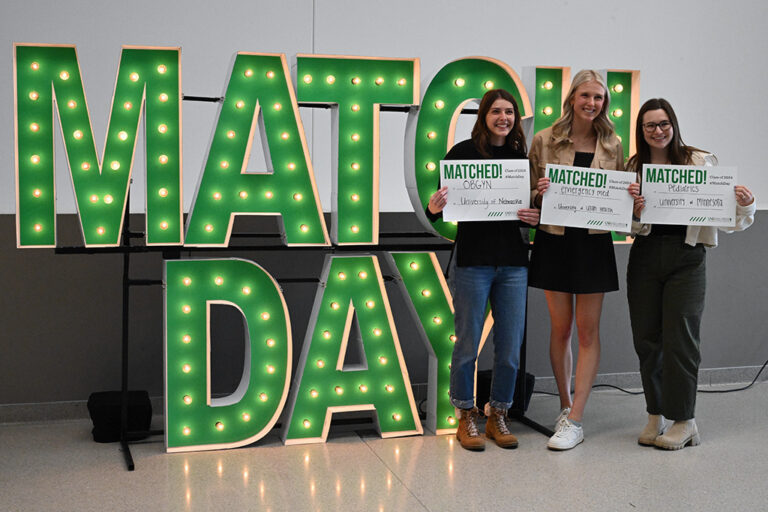The horse and the muskrat
Oklahoma native Judge Muskrat turns a desire to help his community into medical training in North Dakota.
In her Pulitzer Prize winning novel The Night Watchman, Louise Erdrich tells the story of Thomas Wazhashk, a night watchman for a jewel-bearing plant on the Turtle Mountain Reservation in North Dakota. Based on Erdrich’s grandfather, the title character’s surname is the Ojibwe word for “muskrat,” says Erdrich, that “lowly, hardworking” creature that can be found everywhere on the reservation.
And like the muskrat, although Thomas and his family—extended members of the wazhashkag clan—were “numerous and ordinary,” they were also “crucial.”
“In the beginning, after the great flood, it was a muskrat who had helped remake the earth,” Erdrich writes of the figure who helped Indigenous Americans resist the United States Government’s assimilation policies in the 1940s and 1950s. “In that way, as it turned out, Thomas was perfectly named.”
Smiling at the notion, at the reference to his own surname, third-year UND medical student Judge Muskrat concedes that he’s more of a Cormac McCarthy kind of guy.
“I read No Country for Old Men,” laughs Muskrat from his apartment in Grand Forks. “I liked that, but it was kind of dark. I didn’t read All the Pretty Horses, but I read The Road. That was good.”
All the pretty horses
Even though he’s not yet read McCarthy’s National Book Award winner, the Oklahoma native and tribal member of the United Keetoowah Band “grew up riding horses” on a ranch outside of a small town called Webbers Falls in eastern Oklahoma, south of Muskogee.
With its endless acres of untrammeled grasslands, hills, and trees, plus lots of horses, it’s a landscape to which he hopes to return.
“That’s my home,” Muskrat says, describing the shift from rural to more urban living. “I feel like the ranch definitely taught me the value of hard work, because my dad would have us out there hauling hay during summer time. Building fences, working with cows. There’s always something to do on the ranch, and that’s where I learned how to weld, how to work on cars. I learned a lot of life skills there.”
It’s also where he learned the perseverance and grit that have served him well these past few years.
“I’m used to living in the middle of nowhere, where it was nice and quiet and all I heard were crickets and frogs at night,” he explains. “Up here it’s car horns. It definitely took a while to get used to North Dakota—especially the winters.”
Frigid winters notwithstanding, the first-generation medical student ran into another challenge early on in his medical education up north.
“Med school hasn’t been easy for me,” Muskrat admits, noting that he took a leave of absence after his first year. “Living on a ranch, our family motto has been: ‘it’s okay to give in—just don’t give up.’ Get back on the horse. Because if it bucks you off and you don’t ride it again, that horse has won. But you get back on it, you ride it, and you train it not to buck. Just keep getting back on it.”
The road
So Muskrat is back, and on track to begin his clinical training. And in continuing to get back on the medical college horse despite the setback, Muskrat says he is thinking less of himself than his Indigenous community in Oklahoma, which is in desperate need of health providers.
Reciting the statistics—lower life expectancy for American Indians and much higher rates of obesity, diabetes, and hypertension relative to non-Indians—Muskrat says that at least some of the health disparities that continue to plague Indigenous communities are a result of the lack of trust many Indigenous people harbor for non-Indigenous physicians. That is to say: a lack of faith in the entire western health system—particularly one affiliated with the United States government—keeps many American Indians from going to the doctor.
“My mom, she grew up in a boarding school,” he continues. “The first language she ever spoke was Cherokee. She learned English as a second language. When she was in boarding school, and that’s all she knew was Cherokee, every time she would speak it [the instructors] hit her with a ruler.
“Plus the illegal sterilization of Native American women…” he trails off.
Such evidence—personal experience combined with documented anti-Indian policies carried out by health providers less than a century ago—have contributed to a general mistrust of western medicine by many in the Indigenous community, says Muskrat.
“Indigenous people, we have long memories. Even though these things happened a long time ago, we haven’t forgotten.”
So does Muskrat hope to counter what he suggests is a too-high turnover rate of physicians in the Indian Health Service (IHS) system by being that Indigenous provider who wants to be where he is—and intends to stay.
“And so right there, I can eliminate that mistrust in the hospital system. If there’s a local-born doctor, who is Cherokee and from the community, practicing there—that’s huge.”
The crossing
This lack of local mentors—Indigenous providers from and dedicated to Oklahoma—is part of the trend Muskrat hopes to reverse. Having began his adult life as a high school science teacher, he says that although he had considered medicine earlier in life, the lack of resources and local physician mentors in the field in and around his community means that as a youth he doubted medical school was even an option.
“No one in my family is a doctor, or has anything to do with healthcare,” he says. “I had to throw my foot in the door, you know? Go ask for shadowing opportunities.”
So the science teacher applied to medical school, got in, and made his way up to North Dakota, in part because of its nationally-recognized Indians Into Medicine (INMED) program, which Muskrat discovered during an American Indian Science & Engineering Society (AISES) conference he had attended.
In this way did his effort to play a “crucial” role for his tribe shift. Just a bit.
“My goal is to hopefully get into residency in Oklahoma and practice back at home for my tribe,” he says, noting that the Cherokee Nation falls under the section P.L. 93-638 of Title I (the Indian Self Determination and Education Assistance Act) of U.S. Code, meaning that while the IHS provides healthcare funding to the tribe, the agency doesn’t serve the tribe directly.
“And I like the fact that I can serve my own community. Why would I leave home? That’s where my family is.”
Louise Erdrich couldn’t have said it better.


